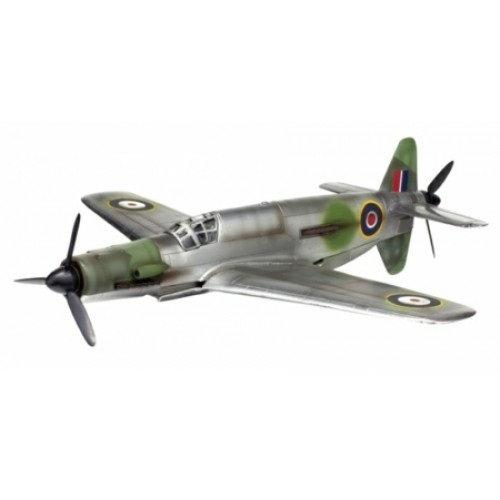Dornier Do 335B Pfeil – Captured Eagle, RAF, Germany, 1945
Add to compare1 in stock
£34.99
1 in stock
War Master WMA7200006: Dornier Do 335B Pfeil Captured Eagle in RAF livery, Germany, 1945. It is believed that this aircraft was due to be flown to RAE Farnborough for evaluation, but force landed in France and was abandoned.
Length 7.5 inches Wingspan 7.5 inches
The Dornier Do 335 Pfeil (“Arrow”) was a World War II heavy fighter built by the Dornier company. It was one of the fastest propeller-driven aircraft ever flown; in fact the Germans claimed that a pilot flew a Do 335 at a speed of 846 km/h (474 mph) in level flight at a time when the official world speed record was 755 km/h (469 mph). Two liquid-cooled engines each developing about 1,750 hp powered the Do 335. Dornier mounted one engine in the nose and the other in the tail in a unique low-drag push-pull configuration. This innovative design also featured an ejection seat, a tail fin which the pilot could jettison, and tricycle landing gear. For a fighter airplane, the Do 335 was enormous: tall enough that a person of normal height could walk beneath it and very heavy at 9,600 kg (21,000 lb) loaded. Serious flaws also plagued the design. The rear engine overheated often and the landing gear was weak and prone to failure.
Claudius Dornier patented the push-pull engine layout in 1937, which was innovative because it offered the power of two engines but less drag and greater maneuverability than other twin-engine configurations. The RLM (German Aviation Ministry) wanted to support development of push-pull aircraft but initially only as seaplanes and bombers. By 1942, the Luftwaffe needed multi-role fighters and after submitting a proposal in January 1943 for a Schnellbomber (fast bomber), Dornier built a prototype Do 335 V-1 (‘V’ for Versuchs or experimental) and the aircraft completed its first flight in September 1943. Following initial testing, the RLM ordered 14 prototypes, ten preproduction aircraft with the suffix designation A-0, eleven production A-1 single-seat aircraft, and 3 A-10 and A-12 two-seat trainers.
Dornier selected two Daimler-Benz DB-603 V-12 cylinder engines to propel the four different versions of the Do 335. Each engine displaced 44.5 liters (2,670 cu in) and weighed 910 kg (2,006 lb). Unlike conventional twin-engine aircraft with wing-mounted engines, the Do 335 would not yaw sharply to one side if one engine failed, and single-engine flying speed remained respectable at about 620 km/h (345 mph). Pilots reported exceptional flight performance in acceleration and turning radius, and docile handling with no dangerous spin characteristics. In an emergency, however, the pilot could detonate explosive bolts and jettison the pusher three-blade propeller and dorsal fin to increase the chances of successfully bailing out using the pneumatic ejection seat. When fired, the seat pushed the pilot away from the aircraft with a force of about 20 Gs.
Dornier finished building as many as 48 Do 335 airplanes and another nine or so were under construction when the war ended. One of many plans issued by the RLM called for Dornier to build 310 Do 335s by late 1945. Although combat conversion units received several pre-production aircraft about 10 months before the war ended, no pilots flew Do 335s in combat. Only one example of the first production version Do 335A-1 rolled off the Dornier assembly line at Friedrichshafen just before the war ended. One 30 mm MK-103 cannon (70 rounds were carried) firing through the propeller hub and two 15 mm MG-151/15 cannon (200 rounds per gun) firing from the top cowling of the forward engine armed this model, and an internal bomb load of 500 kg (1,100 lb) could be carried.
| Weight | 1.2 kg |
|---|

